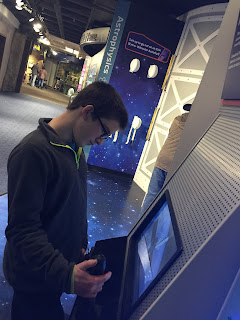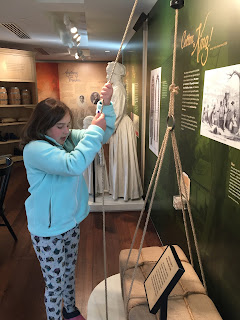 |
| Children's Museum during Jolly Days |
Just before Christmas, we once again visited the Children's Museum of Indianapolis during their Jolly Days holiday programming. We love the Indy Children's Museum (ICM)! For years, we visited at least monthly, often twice a month. It was one of our favorite places! But, as the kids have gotten older, we have moved to visiting about once a year. It's still one of my favorite places : )

The Children's Museum of Indianapolis offers something for everyone, and it is constantly changing and updating. We started the day in the Treasurers of the Earth Exhibit. Featuring archaeological activities from three different settings (An Ancient Egyptian tomb, a sunken pirate ship and the Terra Cotta Warriors of Ancient China), this exhibit could be enjoyed by kids of all ages. While the young ones dug for artifacts, utilized computers to paint the Terra Cotta Warriors, explored around the sunken ship wreck and crawled through Egyptian tomb space, we focused on the actual artifacts housed behind the museum's glass in the Archaeology Lab. We talked with the archaeologist on staff about how they determine the age and origin of the artifacts, and she let the kids help piece together a bowl. Since the others in the exhibit were younger, they offered the program aimed at older visitors just to us, showing us behind the scenes in the lab and letting us ask about anything there of interest. Since my 13 year old is considering a career in archaeology, it was a great opportunity for him to have questions answered and gain a better understanding aimed at his level of knowledge.
 |
| Talking with the Archaeologist |
 |
| Mummy Puzzle |
 |
| The lab |
 |
| The Liberty 7 Program |
We continued into the new Beyond Spaceship Earth Exhibit where we were able to do hands on activities from the space station, watch an excellent program about the Liberty 7 spacecraft, and see exhibits about the many astronauts from Indiana. To me, the space program is so inspiring, and this was an excellent supplement to our recent visit to the Kennedy Space Center in Florida. Well done with activities and programs for all ages.

We continued up to the Power of Children Exhibit where we participated in the live performance of the story of Ruby Bridges, the little girl who fought vast prejudice to attend the previously all white school in Alabama. The program was done from the perspective of a Federal Marshall who accompanied her to school, and it was incredibly powerful. He then led a discussion afterwards, helping the kids see how they can work to make the world a better place now. It was timely and powerful. This program is aimed at older visitors, and nothing was dumbed down or simplified for the kids. There was a message of hope, and it inspired all of us to realize that the little things we do every day can make a big difference in someone's life.

We visited Scienceworks and the newly remodeled water table, which does a great job of explaining the impact of water - rivers, flood planes, grasslands, levees, etc. It is fun to play in and very educational. We looked for the frog and other animals in the habitat there, and we explored the new cave exhibit. Excellent!
 |
| Is this the correct "Tea Ceremony" procedure?? |
We visited Take Me There: China where we made Chinese letters, participated in a formal Chinese Tea Ceremony and explored the homes of Chinese citizens. Although we have done all of this before, the kids learn something new every time they come because they come with different experiences and understanding.
 |
| Calligraphy |
 |
| One of 3 Chinese Houses |
Dinosphere used to be our home away from home. We spent hours digging for dinosaur bones, exploring the exhibits to compare the actual, real skeletons to those we were learning about, talking to the paleontologist. This time our visit to Dinsosphere was quick (we've seen most everything hundreds of times. .), but we always enjoy talking to the paleontologists and exploring the actual bones for new information.
And, of course, we took a couple of trips down the Yule Slide - an annual tradition.
There were many areas we didn't explore this time: The Carousel Wishes
and Dreams and the play areas there, the Doc McStuffins Exhibit,
Playscape, and All Aboard. The kids no longer play with the plastic
dinosaurs or spend hours building in Playscape, but we still spent the
whole day there, enjoying - even with a 10 and 13 year old. Over the years we cultivated relationships with a number of amazing volunteers, staff, paleontologists, archaeologists, and others. We learned a lot through hands on activities that grew with the kids as their knowledge and experiences grew. We enjoyed fun time together, away from the hustle and bustle of daily life. And, we explored and grew as citizens of the world. What a great
resource for Indiana families!
Details:
Winter Hours: Tuesday-Sunday 10-5 (check website for special free days and hours), open Mondays March-August.
Cost:
Youth 2-17: $18.50
Adult 18-59: $22.50
Senior: $21.50
https://www.childrensmuseum.org/
3000 N. Meridian Street
Indianapolis, IN 46208



























































